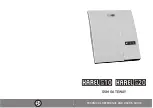
QuadroM 32x/8L/26x/12Li/26xi Manual II: Administrator's Guide
Administrator’s Menus
QuadroM 32x/8L/26x/12Li/26xi; (SW Version 5.2.x)
106
Attention:
When Quadro acts in the Network mode with the Attendant as a destination to route the incoming calls to, digit forwarding should be
disabled on the private PBX side otherwise incoming digits may be mistaken as a special calling codes on the Quadro’s Attendant.
Switch Type
is another configuration parameter that depends on the Service Provider when acting in the User mode and the private PBX
capabilities when acting in the Network mode.
The
Generate Progress Tone to PSTN/PBX
drop-down list contains the options for sending progress (ring-back) tone to callers from the
PSTN/PBX. The following options are available in the list:
•
None
configures the system to send ALERT messages without the Progress Indicator information element (IE).
•
Unconditional
configures the system to send ALERT/PROGRESS messages with the Progress Indicator IE. With this option, the system will
send its own progress tone.
•
Conditional
configures the system to send ALERT/PROGRESS messages with Progress Indicator IE. With this option, the system will send its
own progress tone only if there is no early media (180/183 with SDP) from the called party.
The
Generate Progress tone on IP
checkbox selection will generate the progress tone to IP (H.323 or SIP).
Incoming Called Digits Size
text field indicates the number of received digits (in a range from 0 to 255) required to establish a call. When field has 0
value, system uses either timeout defined in the T302 field or the
Sending Complete Information element
messages to establish a call.
Independent on the value in this field,
Sending Complete Information element
and pound sign always cause the call establishment.
If the
Send ALERT Message on Call Ringing
checkbox is selected, the system will send ALERT messages to callers from the PSTN/PBX on call
ringing. If not, the system will send a PROGRESS message on receiving early media from the called party if the
Generate Progress Tone to
PSTN/PBX
setting is not set to
None
.
Enable CLIR Service
checkbox selection enables Calling Line Identification Restriction (CLIR) service which displays the incoming caller ID only in
case if Presentation Indication is allowed on the remote side. Otherwise, if CLIR service is disabled, caller ID will be unconditionally displayed.
When the
Enable Connect Acknowledge Option
checkbox is selected, Quadro will stop the T303 and T310 timers upon receiving the CONNECT
message, will send a CONNECT ACKNOWLEDGE message to the remote side and enter the active state. When this checkbox is not selected,
Quadro will stop the T303 and T310 timers upon receiving the CONNECT message and will enter the active state without sending the CONNECT
ACKNOWLEDGE message to the remote side.
The
Override CLID with P-Asserted-Identity
checkbox selection enables SIP P-Asserted-Identity support. For the calls from SIP to ISDN if Invite
SIP message contains a P-Asserted-Identity or P-Preferred-Identity or Remote-Party-ID, then the CallerID on ISDN is sent with the value from the
identity field. SIP user agent should check existence of P-Asserted-Identity then P-Preferred-Identity then Remote-Party-ID to fill the identity field.
The
E1/T1 Trunk Status
page provides information about the selected trunk state. Following information is displayed on this page:
•
E1/T1 mode
- displays which mode is selected: E1 or T1.
•
Interface Type
- displays selected interface type: User or Network.
•
Signaling Type
- displays selected signaling type: CAS or CCS.
•
Clock Mode
- displays the selected clock mode: Master or Slave.
•
Framing mode
- displays selected framing mode.
•
Link
- displays E1/T1 link state: up or down.
•
Frame Synchronization
- displays the signal synchronization state in the trunk: Yes or No.
•
Red Alarm
- indicates that the receive frame alignment for the line has been lost and the data cannot be properly extracted. The red alarm is
indicated by the loss of frame condition for the various framing formats.
•
Out of Frame
- number of Out of Frame errors.
•
Line Code Violation
- number of Line Code Violation errors.
•
Frame Synchronization
- number of Frame Synchronization errors.
•
Link Synchronization
- number of Link Synchronization errors.
The following statistics are available, if
CAS Signaling
is selected:
•
Active Calls
- currently active calls in the selected trunk.
•
Outgoing Calls
- total outgoing calls in the selected trunk.
•
Incoming Calls
- total incoming calls in the selected trunk.
Following statistics is available when
CCS Signaling
is selected:
ISDN PRI Layer
statistics:
•
Received Packets
- number of received packets.
•
Received Errors
- number of received errorneous packets.
•
Transmitted Packets
- number of transmitted packets.
•
Transmitted Errors
- number of transmitted errorneous packets.
ISDN PRI Layer 2
statistics is displayed for actual TEI value and the received and transmitted packets:
•
TEI Value
– the actual TEI assigned
•
L2 State
– the state of the TEI assignment















































